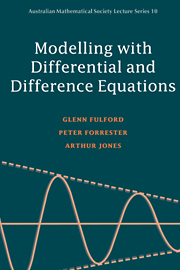Book contents
- Frontmatter
- Contents
- Preface
- Introduction to the student
- Part One Simple Models in Mechanics
- 1 Newtonian mechanics
- 2 Kinematics on a line
- 3 Ropes and pulleys
- 4 Friction
- 5 Differential equations: linearity and SHM
- 6 Springs and oscillations
- Part Two Models with Difference Equations
- Part Three Models with Differential Equations
- Part Four Further Mechanics
- Part Five Coupled Models
- References
- Index
6 - Springs and oscillations
Published online by Cambridge University Press: 05 June 2012
- Frontmatter
- Contents
- Preface
- Introduction to the student
- Part One Simple Models in Mechanics
- 1 Newtonian mechanics
- 2 Kinematics on a line
- 3 Ropes and pulleys
- 4 Friction
- 5 Differential equations: linearity and SHM
- 6 Springs and oscillations
- Part Two Models with Difference Equations
- Part Three Models with Differential Equations
- Part Four Further Mechanics
- Part Five Coupled Models
- References
- Index
Summary
This chapter is based on a simple model for the force in a spring which was first proposed by Robert Hooke, a contemporary of Newton. In this model, the force exerted by a spring is assumed to be directly proportional to the distance by which the spring is extended. It is quite a useful model when the extension of the spring is not too large.
Some interesting mechanical systems arise when particles are attached to the ends of springs. A consequence of Hooke's law is that the equations of motion for such particles are linear differential equations, usually the SHM equation or some simple variant of it. The solutions of these differential equations can be expressed in terms of trigonometric functions and hence the model predicts oscillatory motion for the particles.
Later in the book, when you have learned more about differential equations, you will be able to include the effect of damping forces in the model.
Oscillatory phenomena occur widely in nature: the alternate rising and setting of the sun, the waxing and waning of the moon, the ebb and flow of the tides are examples from physics, while the regular beating of your heart is an equally familiar example from biology. Although these phenomena may all be described by differential equations, these differential equations turn out to be non-linear and hence much harder to solve than the simple linear ones used in this chapter.
- Type
- Chapter
- Information
- Modelling with Differential and Difference Equations , pp. 85 - 102Publisher: Cambridge University PressPrint publication year: 1997

